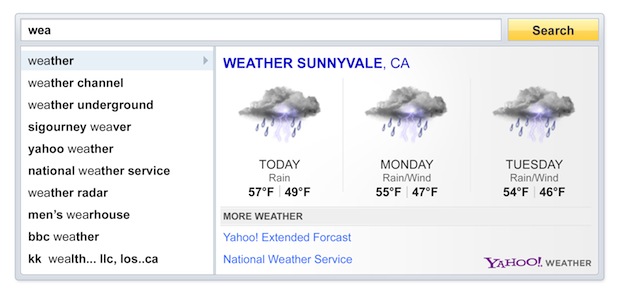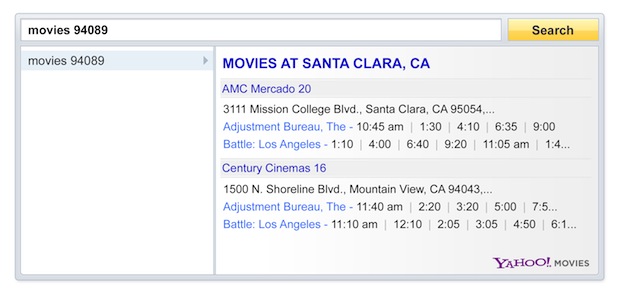
Yes, Yahoo is launching a new product today that you might actually be interested in. It’s derivative, but it looks useful.
Today at a press event in San Francisco, the company announced the launch of a new product called ‘Search Direct’. It looks a lot like Google Instant: as you start typing a query into Yahoo Search, the site will begin populating results with each new character entered (in other words, you don’t have to hit the ‘return’ key). The feature is now live at search.yahoo.com.
Google Instant, of course, has done something very similar since September. But Yahoo says that Search Direct is looking to help match users with “answers, not links”. As you start typing, a small rectangular widget will slide down from the search bar and show rich results whenever available — do a query for “Derrick”, and you’ll see quick breakdown of basketball player Derrick Rose’s stats. Search for a city and you’ll see weather widgets and nearby sports team schedules — you can jump between these rich results using the arrow keys on your keyboard. Google Instant also shows rich results when possible, but Yahoo Search Direct does seem faster, in part because it isn’t refreshing the whole page.
Asked about how this compares to Google Instant, Yahoo SVP of Search Products Shashi Seth says “They’re very different products. We’re focused on providing answers, not links. Google Instant is focused on providing more links, faster. Not answers. We believe the next generation of search regardless of whether it’s on the web or mobile, they’re looking for answers, not links.” I suspect Google would strongly disagree with this assertion, as the search giant has long been increasing the number of rich results it displays in addition to the ten blue links.
Asked about how Yahoo provides its results so quickly, Shashi says that they are generated by a completely different infrastructure from its normal search servers. The infrastructure is “significantly smaller” — Yahoo is using around 15 categories of data, but says it could eventually expand to include “hundreds of categories”. Some of the categories at this point: sports, music, celebrities, weather, news, shopping, local.
Yahoo will be monetizing the new features by allowing advertisers to embed images or videos in the right-pane (run a query for Gap, and you might see a YouTube ad for the Gap in this rich content area). Which seems to defeat the purpose (if I’m expecting rich, contextual results, I don’t want them to be completely replaced by an ad), but it sounds like Yahoo is still experimenting with these.
Shashi says that this will be eventually be available on the iPad, where they say it will be especially useful. This isn’t available yet and will look different when it does launch.
Yahoo EVP, Chief Product Officer Blake Irving says that while Yahoo has outsourced part of its search efforts, it still knows that “search matters. It matters to customers, and it matters to us. Microsoft is doing our paid search and algorithmic backend.” But he says that frees Yahoo’s engineers up to work on other improvements. He also mentioned that you might see this appearing on websites outside of Yahoo.com.
-
Some other notes:
- Yahoo does want to incorporate Facebook results into its search
- Yahoo is experimenting with introducing more search features, displaying results based on what friends have searched for/shared
- The Q&A has circled back to Google Instant a couple times. Shashi acknowledges that Google has in fact tried to include richer results beyond the 10 blue links, but says that Yahoo will present rich results for a much broader number of queries.
- Irving says “Lots” of people are working on search
- As far as integration of other sites, Irving says that the algorithmic backend pushes data from Associated Content, licensed content, and original content from Yahoo’s own site (third party publishers will also be adding their data).
- Yahoo has plans to bring the Direct Search experience elsewhere, though the plans sound vague at this point. Shashi says Yahoo hopes to let users integrated it into their browser chrome and search boxes elsewhere on the web
